Motion User Guide
- Welcome
- What’s new in Motion
-
- Intro to basic compositing
-
- Intro to transforming layers
-
- Intro to transforming layers in the canvas
- Transform layer properties in the canvas
- Transform tools
- Change layer position, scale, or rotation
- Move a layer’s anchor point
- Add a drop shadow to a layer
- Distort or shear a layer
- Crop a layer
- Modify shape or mask points
- Transform text glyphs and other object attributes
- Align layers in the canvas
- Transform layers in the HUD
- Transform 2D layers in 3D space
-
- Intro to behaviors
- Behaviors versus keyframes
-
- Intro to behavior types
-
- Intro to Parameter behaviors
- Audio behavior
- Average behavior
- Clamp behavior
- Custom behavior
- Add a Custom behavior
- Exponential behavior
- Link behavior
- Logarithmic behavior
- MIDI behavior
- Add a MIDI behavior
- Negate behavior
- Oscillate behavior
- Create a decaying oscillation
- Overshoot behavior
- Quantize behavior
- Ramp behavior
- Randomize behavior
- Rate behavior
- Reverse behavior
- Stop behavior
- Track behavior
- Wriggle behavior
-
- Intro to Simulation behaviors
- Align to Motion behavior
- Attracted To behavior
- Attractor behavior
- Drag behavior
- Drift Attracted To behavior
- Drift Attractor behavior
- Edge Collision behavior
- Gravity behavior
- Orbit Around behavior
- Random Motion behavior
- Repel behavior
- Repel From behavior
- Rotational Drag behavior
- Spring behavior
- Vortex behavior
- Wind behavior
- Additional behaviors
-
- Intro to using generators
- Add a generator
-
- Intro to image generators
- Caustics generator
- Cellular generator
- Checkerboard generator
- Clouds generator
- Color Solid generator
- Concentric Polka Dots generator
- Concentric Shapes generator
- Gradient generator
- Grid generator
- Japanese Pattern generator
- Lens Flare generator
- Manga Lines generator
- Membrane generator
- Noise generator
- One Color Ray generator
- Op Art 1 generator
- Op Art 2 generator
- Op Art 3 generator
- Overlapping Circles generator
- Radial Bars generator
- Soft Gradient generator
- Spirals generator
- Spiral Drawing generator
- Use Spiral Drawing onscreen controls
- Star generator
- Stripes generator
- Sunburst generator
- Truchet Tiles generator
- Two Color Ray generator
- Save a modified generator
-
- Intro to filters
- Browse and preview filters
- Apply or remove filters
-
- Intro to filter types
-
- Intro to Color filters
- Brightness filter
- Channel Mixer filter
- Color Adjustments filter
- Color Balance filter
- Example: Color-balance two layers
- Color Curves filter
- Use the Color Curves filter
- Color Reduce filter
- Color Wheels filter
- Use the Color Wheels filter
- Colorize filter
- Contrast filter
- Custom LUT filter
- Use the Custom LUT filter
- Gamma filter
- Gradient Colorize filter
- HDR Tools filter
- Hue/Saturation filter
- Hue/Saturation Curves filter
- Use the Hue/Saturation Curves filter
- Levels filter
- Negative filter
- OpenEXR Tone Map filter
- Sepia filter
- Threshold filter
- Tint filter
-
- Intro to Distortion filters
- Black Hole filter
- Bulge filter
- Bump Map filter
- Disc Warp filter
- Droplet filter
- Earthquake filter
- Fisheye filter
- Flop filter
- Fun House filter
- Glass Block filter
- Glass Distortion
- Insect Eye filter
- Mirror filter
- Page Curl filter
- Poke filter
- Polar filter
- Refraction filter
- Ring Lens filter
- Ripple filter
- Scrape filter
- Sliced Scale filter
- Use the Sliced Scale filter
- Sphere filter
- Starburst filter
- Stripes filter
- Target filter
- Tiny Planet filter
- Twirl filter
- Underwater filter
- Wave filter
-
- Intro to Stylize filters
- Add Noise filter
- Bad Film filter
- Bad TV filter
- Circle Screen filter
- Circles filter
- Color Emboss filter
- Comic filter
- Crystallize filter
- Edges filter
- Extrude filter
- Fill filter
- Halftone filter
- Hatched Screen filter
- Highpass filter
- Indent filter
- Line Art filter
- Line Screen filter
- MinMax filter
- Noise Dissolve filter
- Pixellate filter
- Posterize filter
- Relief filter
- Slit Scan filter
- Slit Tunnel filter
- Texture Screen filter
- Vignette filter
- Wavy Screen filter
- About filters and color processing
- Publish filter controls to Final Cut Pro
- Using filters on alpha channels
- Filter performance
- Save custom filters
-
- Intro to 3D objects
- Add a 3D object
- Move and rotate a 3D object
- Reposition a 3D object’s anchor point
- Exchange a 3D object file
- 3D object intersection and layer order
- Using cameras and lights with 3D objects
- Save custom 3D objects
- Guidelines for working with 3D objects
- Working with imported 3D objects
-
- Intro to 360-degree video
- 360-degree projects
- Create 360-degree projects
- Add 360-degree video to a project
- Create a tiny planet effect
- Reorient 360-degree media
- Creating 360-degree templates for Final Cut Pro
- 360-degree-aware filters and generators
- Export and share 360-degree projects
- Guidelines for better 360-degree projects
-
- Intro to settings and shortcuts
-
- Intro to Keyboard shortcuts
- Use function keys
- General keyboard shortcuts
- Audio list keyboard shortcuts
-
- Tools keyboard shortcuts
- Transform tool keyboard shortcuts
- Select/Transform tool keyboard shortcuts
- Crop tool keyboard shortcuts
- Edit Points tool keyboard shortcuts
- Edit shape tools keyboard shortcuts
- Pan and Zoom tools keyboard shortcuts
- Shape tools keyboard shortcuts
- Bezier tool keyboard shortcuts
- B-Spline tool keyboard shortcuts
- Paint Stroke tool keyboard shortcuts
- Text tool keyboard shortcuts
- Shape mask tools keyboard shortcuts
- Bezier Mask tool keyboard shortcuts
- B-Spline Mask tool keyboard shortcuts
- Transport control keyboard shortcuts
- View option keyboard shortcuts
- HUD keyboard shortcuts
- Inspector keyboard shortcuts
- Keyframe Editor keyboard shortcuts
- Layers keyboard shortcuts
- Library keyboard shortcuts
- Media list keyboard shortcuts
- Timeline keyboard shortcuts
- Keyframing keyboard shortcuts
- Shape and Mask keyboard shortcuts
- 3D keyboard shortcuts
- Miscellaneous keyboard shortcuts
- Touch Bar shortcuts
- Move assets to another computer
- Work with GPUs
- Glossary
- Copyright

Use the Color Curves filter in Motion
You can use color curves to adjust the components of individual color channels in an image. You can adjust the global luma channel as well as the red, green, and blue color channels. You can also select a custom color in a clip and adjust its intensity, or select a mix of different colors in a clip and adjust their intensities at the same time.
When you apply the Color Curves filter, its settings appear in the Filters Inspector:
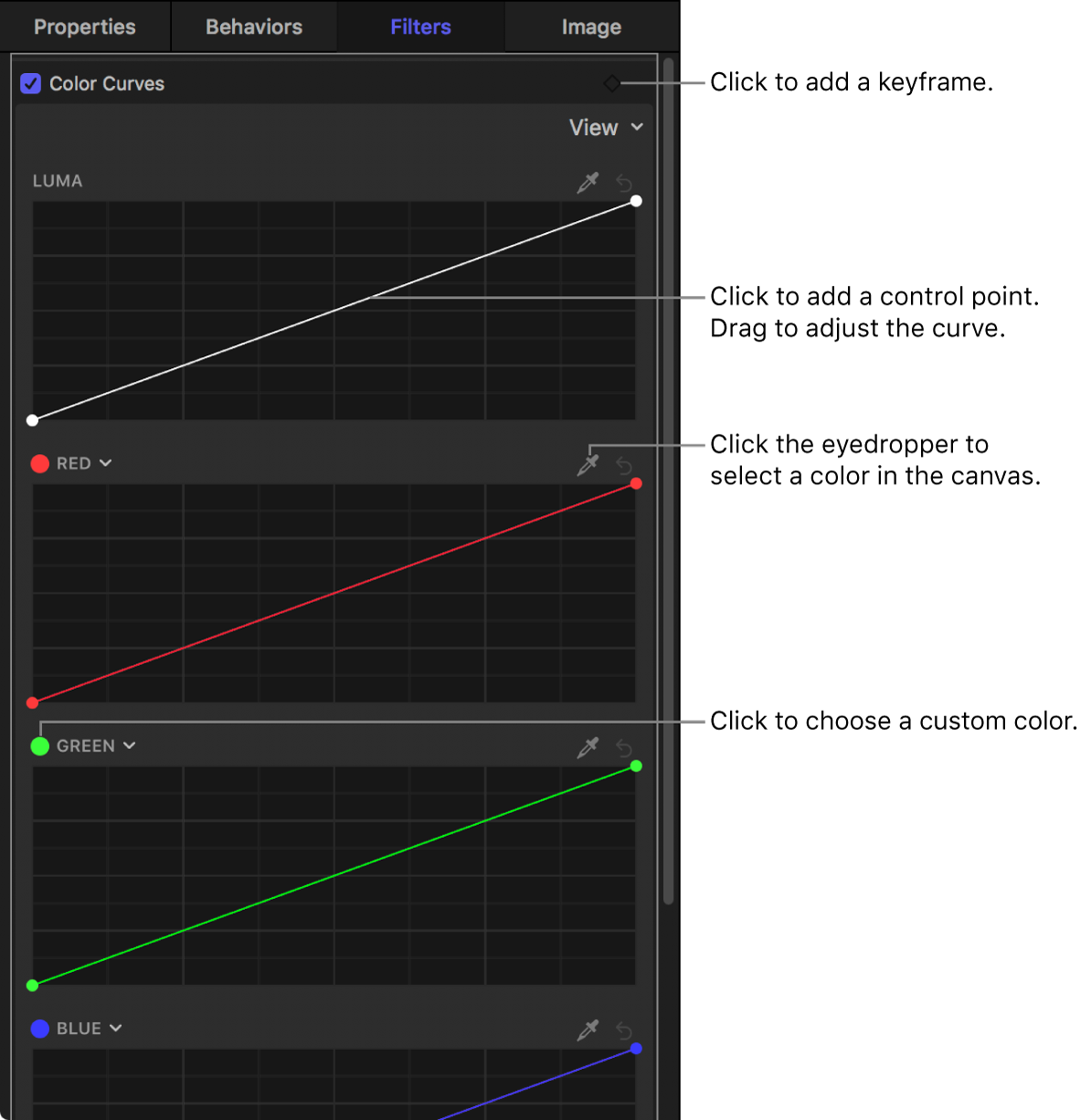
A color curve is a graph that lets you remap a color channel’s luminance (intensity) values. The straight diagonal line represents the tonal ranges of the color channel before you make changes to the image, with shadows on the left side of the diagonal line, midtones in the center, and highlights on the right.
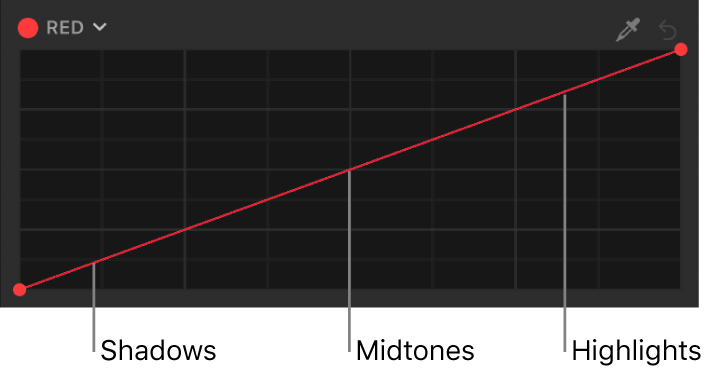
The vertical axis in the graph represents the luminance changes you make to the color channel, by dragging up or down at any point along the diagonal line. So, for example, in the Red curve control, dragging up on the left side of the diagonal line increases the intensity of red in the shadows—making the dark areas look more intensely red. Dragging down on the left side of the line reduces the intensity of red in the shadows—making the dark areas look more blue-green.
Note: Because you can apply multiple color filters to an image, you’re not required to follow all of the steps below, nor the order of those steps. For example, you might adjust the overall contrast with the Color Curves filter and adjust a color tint with the Color Wheels filter. Or you could achieve the same results with multiple instances of the same effect.
Tip: You can simultaneously animate all parameters of the Color Curves filter. See Globally animate all parameters of a Color Curves, Color Wheels, or Hue/Saturation Curves filter.
Apply the Color Curves filter
In Motion, open the Library, click the Filters category, then click the Color category to reveal the color-correction filters.
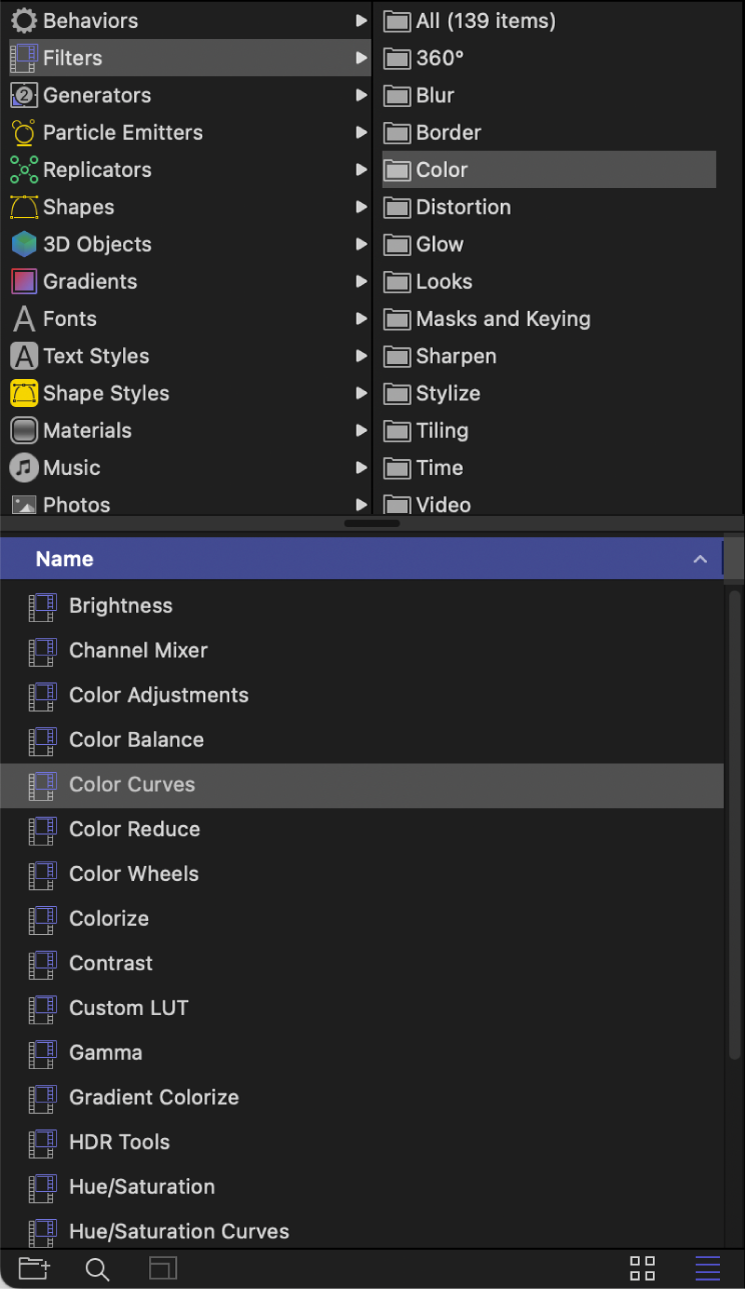
Drag the Color Curves filter to the layer in the Layers list you want to adjust.
The Color Curves controls appear in the Filters Inspector.
In the Filters Inspector, click the View pop-up menu at the top of the filter controls and choose a display option:
All Curves: Displays all four curves (Luma, Red, Green, and Blue) at once.
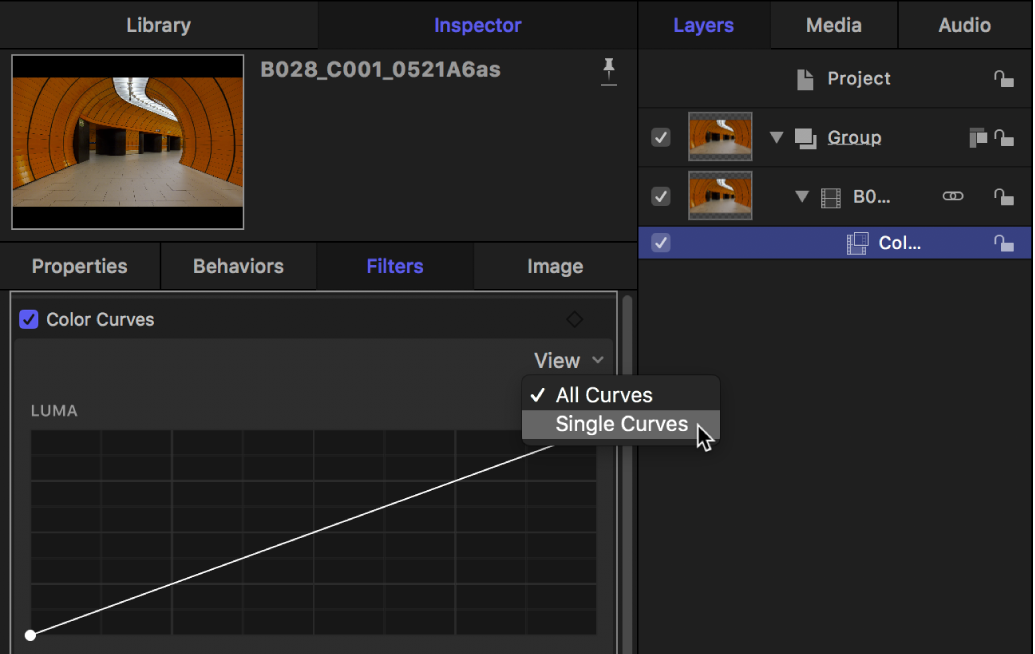
Single Curves: Displays one large curve at a time. In Single Curves view, click a button above the curve to display a specific curve.
To color-correct the image, follow the instructions below.
Adjust the intensity of a primary color channel or luma channel
In Motion, apply a Color Curves filter to a clip or image, as described in the previous task.
Do one of the following:
Adjust a primary color channel: Click the Red, Green, or Blue curve (the diagonal line) to add a control point.
Tip: Click somewhere on the lower-left side of the line to adjust mostly shadows of a given color; click in the center of the line to adjust mostly midtones; or click the upper-right side of the line to adjust mostly highlights
Adjust the luma channel: To set the black and white points, drag the control points on the ends of the Luma curve. Click the Luma curve (the white diagonal line) to add a control point.
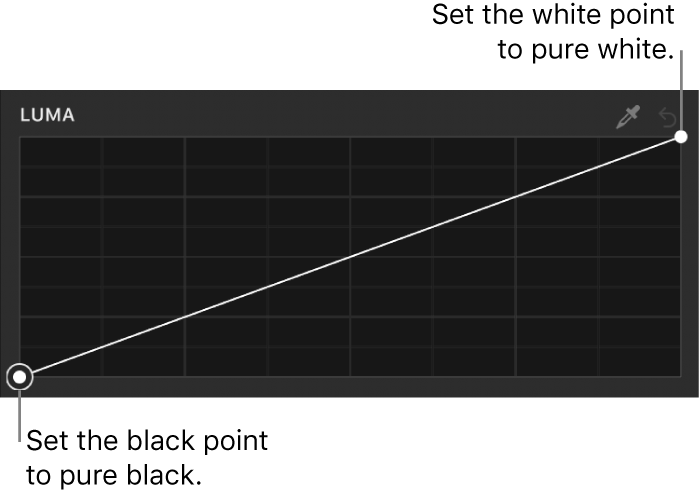
Adjust the white point to modify the very brightest parts of an image; adjust the black point to modify the very darkest parts of an image. You can expand the tonal range of your image by increasing the white point and black point as far as you can without clipping (forcing values out of the allowable range).
Drag the control point up to increase the intensity of the color or luma value, or down to decrease the intensity.
To constrain the control point to vertical or horizontal movement, press and hold the Shift key as you drag. To make fine adjustments, press and hold the Option key as you drag.
Adjusting the image with a single control point affects most of the midtones as well as some shadows and highlights.
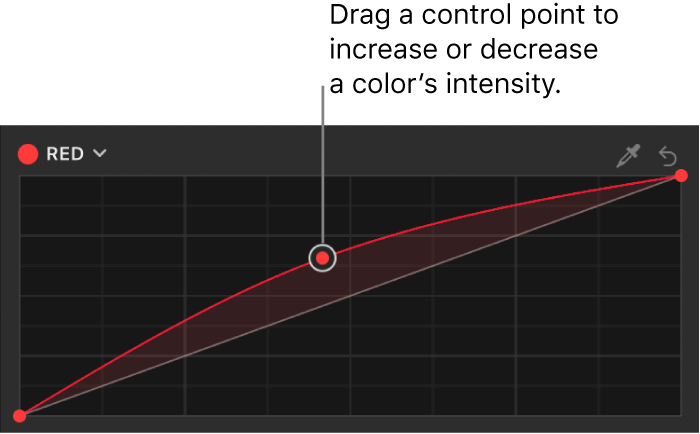
To narrow the tonal range for your adjustments, add more control points.
The default diagonal line for each curve indicates the original state of the image. Wherever the curve diverges from the diagonal line, the image is altered. Wherever the curve touches the diagonal line, the values of the image at that tonality are the same as in the original image. For example, to prevent any change to the shadows, you could add a control point to pin the curve to the diagonal line in the shadows area.

Add and drag control points as needed.
To delete a control point, select it and press Delete.

To reset the values for a color curve, click its reset button (the curved arrow). To reset the values for all color curves and value sliders, move the pointer over the upper-right corner of the filter controls, then click the Animation pop-up menu (the down arrow that appears) and choose Reset Parameter.
At the bottom of the filter controls, adjust any of the following:
Preserve Luma: Select this checkbox to maintain the overall brightness of a clip despite changes in one or more color channels.
Mix: Set the amount of the original image that’s blended with the color-corrected image.
Adjust the intensity of a custom color or range of colors
You can also select a custom color or a range of custom colors and then adjust the intensity.
In Motion, apply a Color Curves filter to a clip or image.
Do one of the following:
Select a custom color using the eyedropper tool: Click the eyedropper tool at the top of one of the color curves, then click in the canvas to select a single color, or drag in the canvas to select a range of colors.
Select a custom color using a color wheel control: Click the name of a color curve (in the top-left corner of the curve), then click or drag in the color wheel.

Click the curve (the diagonal line) to add a control point.
To delete a control point, select it and press Delete.
Tip: Click somewhere on the lower-left side of the line to adjust mostly shadows of a given color; click in the center of the line to adjust mostly midtones; or click the upper-right side of the line to adjust mostly highlights.
Drag the control point up to increase the intensity of the color or down to decrease its intensity.
To narrow the tonal range for your adjustments, add more control points.
Reduce color cast in a clip
If a clip wasn’t white-balanced properly during shooting, it may exhibit a strong color cast (a bluish or other hue). Oftentimes, you can correct or reduce this issue using the Color Curves filter.
In Motion, apply a Color Curves filter to the clip or image.
Click the eyedropper tool at the top of one of the color curves, then click or drag in the canvas over an area of the image that’s supposed to be white, such as a white sheet of paper.
A vertical gray line appears on the color curve.
Click to add a control point where the gray line intersects the curve, then drag the control point down until the selected color in the canvas turns white.
To delete a control point, select it and press Delete.
After you apply a color correction, you can copy it to another image or group. See Copy and paste a filter to another layer or group.
Tip: If you frequently add a particular color filter, you can speed up your workflow by saving the correction as a Motion template. (However, you cannot publish the Color Curves filter as a custom Final Cut Pro effects template.)
Download this guide: PDF